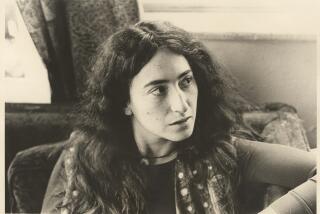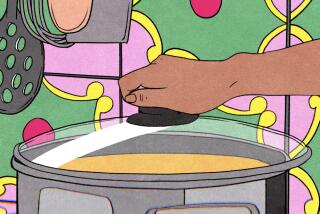A Humanist Departs : Fire Still Burns in Gentle Peace Activist--but the Years, Finally, Exact a Toll
She is an unabashed humanist.
A color poster of the planet Earth hangs in the entryway of her Santa Paula home. She embraces visitors with a grip surprisingly strong for a 92-year-old, and sits as close to them as she can, reminding them âweâre huddling for humanity.â
An exuberant nude adorns a living room wall and a copy of Mother Jones magazine sits on the coffee table. Juanita Kallmeyer speaks spiritedly of the Rev. Jesse Jackson (sheâs a big fan) the bomb, youth and the future. She speaks more matter-of-factly about her impending move from the house from which she has dispensed poetry and propaganda, all in the name of peace, and become something of a symbol of grass-roots goodness over the last three decades.
âItâs going to be tough leaving my home and relying on other people after taking care of the world all of these years,â Kallmeyer said with a laugh. âIâve always been so independent. But Iâm programming my computer to think positively.â
It already is.
Failing Eyesight
Kallmeyer, who is nearly blind, maintains a brisk, optimistic correspondence with leaders of the peace movement in the United States and the Soviet Union, with congressmen and college students and with like-minded Ventura County citizens she calls her âconstituents.â
She does not dwell on her troubles. Her husband, Dutch, died last March. Recently, she injured her back, and is occasionally jolted by shooting pains. Managing on her own is becoming a riskier proposition, so, in a couple of weeks, sheâll take her leave of Santa Paula and move in with her daughter, Patricia Buck, a nurse in Whittier.
Friends, neighbors and community leaders say sheâll be sorely missed.
âWeâll miss her insight into the worldâs problems and her enthusiasm for sharing her beliefs,â said Marianne Ratcliff, editor of the Santa Paula Daily Chronicle, in reference to the more than 150 poems, opinion pieces and letters by Kallmeyer that have been published in the Chronicle during the last 10 years.
âShe calls here frequently to talk to the reporters and the editors . . . sometimes about new ideas she has, but often just to say âthank youâ for printing her poems and letters. We hope sheâll send us more,â Ratcliff added.
Until her recent back injury, Kallmeyer would get up long before dawn, writing her thoughts on paper or using a tape recorder to capture the words that would swirl in her head.
Then, at sunrise, she would put her intellectual tasks aside and put her body to work.
Dressed in a childâs blanket-pajama suit, the 4-foot, 10-inch Kallmeyer would warm up with 300 bounces and twists on a homemade trampoline in her garage, jog several laps up and down her long gravel driveway, and finish up with a calisthenic routine indoors.
She credits the rigorous exercise with giving her the energy to pursue her favorite avocation--writing poetry laden with pleas for nuclear disarmament and an ecologically sound environment.
âWeâre running out of time,â says Kallmeyer. âIf we donât change our thinking soon, weâre going to destroy this planet of ours.â
While her message is hardly new, her presentation has drawn notice.
âA woman whoâs 92 years old, whoâs espousing peace and putting herself on the line in a very active way, even though sheâs subject to scorn and criticism and being dismissed, deserves to be listened to,â says Carole Hemingway, a Los Angeles radio talk-show host who has read Kallmeyerâs letters and poems on the air.
âJuanita Kallmeyer is saying something important and she says it well,â Hemingway said. âSheâs the kind of person we should be listening to.â
Dr. Bernard Lown, co-president of International Physicians for the Prevention of Nuclear War, the organization that won the Nobel Peace Prize in 1985, offered her the same sort of testimonial.
Poetry Praised
âI was deeply moved by your letter,â he wrote her in 1986. âThe fortitude to continue the struggle at 90 is a testament of profound human commitment. . . . Your poems are a powerful means of organizing people, of reaching the uncommitted and of bringing the human family a mite closer. . . .â
Dr. E. Chazov, a peace activist in the Soviet Union, agreed.
âIt is with deep gratitude and appreciation that I learned about your tireless efforts, at 90, to promote the noblest cause--world peace,â he wrote in response to one of Kallmeyerâs notes. âFor me and my colleagues in the Soviet Committee of Physicians for the Prevention of Nuclear War, your endeavors are a source of inspiration and optimism.â
The poetry she unleashes on a mailing list of about 40 peace activists, politicians, scientists, students, college administrators and friends makes its point in no uncertain terms:
âWe know that peace-mongering is not very profitable,
But weâd better shine it up and make it more marketable
And hope that we see the light before we feel the heat,
For it wonât be just the innocent and the weak.
We are all part of âMother Earthâ--thereâs not time to fuss.
It used to be us and them--now thereâs only us.â
Kallmeyer became an advocate rather late in life.
Born Cora Juanita Johnson in Tunis, Mo., in 1896, she grew up in Los Angeles and studied nursing at the cityâs old Crocker Street Hospital and then at Seaside Hospital.
Her marriage in 1922 produced four daughters and two sons who were raised on the natural foods that Kallmeyer grew herself.
Her âjewels,â as she calls her children, were so healthy that the five oldest were each pictured in turn in Bernarr McFaddenâs Physical Culture Magazine in the 1920s and early â30s.
It was her second husband, Dutch Kallmeyer, who helped her become acutely aware of issues beyond her family and home, Kallmeyer recalled.
âHe would tell me what was happening in the world and eventually I realized I had a responsibility for more than my own back yard,â she said.
She had dabbled with poetry for years, but she didnât take it seriously until her health and eyesight began to fail in her 70s.
âI was exhausted and had to do something with my head instead of my body,â she said.
Dutch began reading newspaper articles to her and encouraged her to listen to radio and TV news programs, to talk shows and tape-recorded books and speeches.
At first, she wrote for her children, grandchildren and great-grandchildren so they would understand âhow the world ticks,â she said. âNow, Iâm committed to reaching as many people as possible about peace, humanity and the environment.â
A son-in-law has compiled her work into four volumes, each titled âObservationâ--âwith no âs,â because Iâm not through observing yet,â Kallmeyer said.
Because she rarely leaves home these days, Kallmeyer loves to have visitors--especially those who discuss her work. She prepares a detailed agenda for each visit and organizes her poems, letters and articles in a box for easy reference.
She laughs easily, and emphasizes particular concerns with a tap of her finger on her visitorâs arm or shoulder. She is delighted when her listener reads her poetry back to her. As she listens, she will say âyes!â or repeat certain words sheâs just heard.
âI just want to stress certain points,â she explained. âItâs crazy, I know.â
How many more poems Kallmeyer will write or people sheâll reach out to with her message is uncertain now that sheâs moving.
She herself has the feeling sheâs on the brink of a new experience and talks about her new home as a âhalfwayâ station.
âI donât really know what will happen next,â she said. âIâm trying to put the finishing touches on my life now.â
More to Read
Sign up for Essential California
The most important California stories and recommendations in your inbox every morning.
You may occasionally receive promotional content from the Los Angeles Times.










